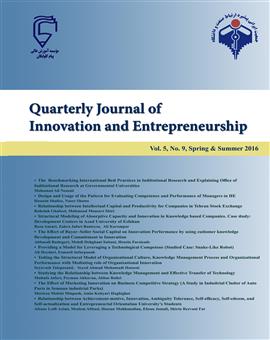Providing a Model for Leveraging a Technological Competene (Studied Case: Snake-Like Robot)
Subject Areas :علی حیدری 1 * , esmaeil jafarpanah 2
1 - Tehran University
2 - Tehran University
Keywords: Technological Competence Leveraging Process/Path, High-Technology Products, Fuzzy Multi-Attributes Decision Making, Snake-Like Robot,
Abstract :
Nowadays, one of the most important dynamic capabilities of technology-intensive firms is leveraging of technological achievements for the creation of new applications and products and as a result, the new markets. This research studied the snake-like robot technological competence and its main purpose is to determine the starting point for leveraging process/path of this competence. For this purpose, available target markets for leveraging this competence have been identified and then have been ranked with performing multi-attributes decision making through ANP-DEAMATEL and TOPSIS hybrid model in fuzzy environment. Research experts have been selected from industrial knowledge intensive firms and scientific associations related to this competence. Multi-attribute decision making model results, based on data from experts, show that oil industry has the most attractiveness for starting of snake-like robot leveraging. The model presented in this research, with some modifications and adjustments can also be used for other high-technology products.
Barney, J. (1991). Firm resources and sustained competitive advantage. Journal of management, 17(1), 99-120.
Danneels, E. (2002). The dynamics of product innovation and firm competences. Strategic management journal, 23(12), 1095-1121.
Danneels, E. (2007). The process of technological competence leveraging.Strategic Management Journal, 28(5), 511-533.
Drejer, A. 2001. How we define and understand competencies. Technovation 21, no. 3: 135–46.
Guptat, U. (2010). Insight into firm’s strategy for leveraging technological competences in Asia. Journal of intellectual Property Rights, 15, 130-137.
Hamel, G., & Heene, A. (1994). Competence-based competition. Wiley.
Hopkins, J.K., Spranklin, B.W., Gupta, S.K., (2009). A survey of snake-inspired robot designs, Bionispiration and Biomimetics, 4(2).
Huang, K. F. (2011). Technology competencies in competitive environment. Journal of Business Research, 64(2), 172-179.
Huynh, V.N. & Nakamori, Y. (2009). A linguistic screening evaluation model in new product development, IEEE Transactions on Engineering Management, 56 (4): 1-11.
Lee Amy H.I., Wen-Chin Chen, Ching-Jan, Chang (2008). A fuzzy AHP and BSC approach for evaluating performance of IT department in the manufacturing industry in Taiwan, Expert Systems with Applications, 34 (1): 96–107.
Lee, J.R., and J.S. Chen. (2000). Dynamic synergy creation with multiple business activities: Toward a competence-based growth model for contract manufacturers. In Research in competence-based management, ed. R. Sanchez and A. Heene, 209–28. London : Elsevier.
Liu, H. Y., & Liu, F. H. (2011). The process of competence leveraging in related diversification: a case of technology management at a composite-material company. Technology Analysis & Strategic Management, 23(2), 193-211.
Markides, C.C., and P.J.Williamson. (1994). Related diversification, core competences and corporate performance. Strategic Management Journal, 15 (special issue): 149–65.
McEvily, S. K., Eisenhardt, K. M., & Prescott, J. E. (2004). The global acquisition, leverage, and protection of technological competencies. Strategic Management Journal, 25(8‐9), 713-722.
Mohanty, R.P., Agarwal, R., Choudhury, A.K. and Tiwari, M. (2005). A fuzzy ANP-based approach to R&D project selection: a case study, International Journal of Production Research, 43 (24): 5199-216.
Prahalad, C. K., & Hamel, G. (2006). The core competence of the corporation (pp. 275-292). Springer Berlin Heidelberg.
S.L. Chan and W.H. Ip (2010). A Scorecard-Markov model for new product screening decisions, journal of Industrial Management & Data Systems, 110 (7): 971-992.
S.L. Chan, W.H. Ip, C.K. Kwong (2011). “Closing the loop between design and market for new product idea screening decisions”, Expert Systems with Applications,Vol 38, p. 7729–7737.
Teece, D. J., Pisano, G., & Shuen, A. (1997). Dynamic capabilities and strategic management. Strategic management journal, 18(7), 509-533.
Teece, D.J., R. Rumelt, G. Dosi, and S.G.Winter. (1994). Understanding corporate coherence – theory and evidence. Journal of Economic Behavior and Organization, 23, no. 1: 1–30.
Tseng, M. (2009). “Using the extension of DEMATEL to integrate hotel service quality perceptions into a cause–effect model in uncertainty.” Expert Systems with Applications, 36(5), PP. 9015-9023.
Wang, Ray,. Shu-Li, Hsu, Yuan Hsu Lin, Ming-Lang Tseng (2011). Evaluation of customer perceptions on airline service quality in uncertainty, Procedia - Social and Behavioral Sciences, 25: 419-437.
Xiaojun Wang, Hing Kai Chan , Dong Li (2015). “A case study of an integrated fuzzy methodology for green product development”, European Journal of Operational Research , Vol. 241 , p. 212–223.
Xu, L., Li, Z.B., Li, S.C. and Tang, F.M. (2007). A decision support system for product design in concurrent engineering, Decision Support Systems, 42 (4): 2029-42.
Wang, Y., & Lo, H. P. (2003). Customer-focused performance and the dynamic model for competence building and leveraging: A resource-based view. Journal of Management Development, 22(6), 483-526.

